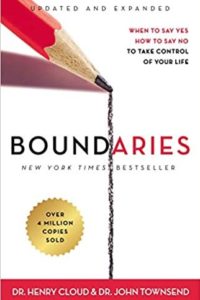Boundaries by Cloud & Townsend

“I wish I had read this earlier.” It’s the sentiment of many who read this book.
Imagine living with an aging mother who manipulates with guilt, a 9-year-old son who throws tantrums when disciplined, a husband who doesn’t text when he’s late, and a boss who gives you more work than you can do. You can’t start that diet, you don’t have time for friends, and you’re always running late.
Such is a day in a boundaryless life, and how Boundaries by Cloud and Townsend begins.
In this world, some might respond with anger, others with guilt or fear. There might be nagging, yelling, pleading. Little things are suddenly emotionally charged.
Love doesn’t always mean saying ‘yes.’ Sometimes it means saying ‘no’—which is itself a one-word boundary.
Boundaries teaches about personal responsibility and leads us into healthy relationships. We’re responsible to others and for ourselves. Our feelings and actions are within our sphere of control—they belong to us. The feelings and actions of others are outside of our control—we are responsible to them, but not for them.
So when an aging mother manipulates with guilt, healthy boundaries keep you from being sucked in. It helps you sort through which problems belong to you, which problems belong to others, and gives the freedom to act accordingly. Your mom’s manipulation is her issue, not yours—and you are free to say no.
Boundaries are about setting and respecting limits, and revolve around saying and hearing ‘yes’ and ‘no.’ If we can’t say no, we can’t say yes.
Here are four types of boundary problems:
| CAN’T SAY | CAN’T HEAR | |
| NO | The Compliant Feels guilty and/or controlled by others; can’t set boundaries |
The Controller Aggressively or manipulatively violates boundaries of others |
| YES | The Nonresponsive Sets boundaries against responsibility to love |
The Avoidant Sets boundaries against receiving care of others |
As a pleaser and performer, I have tended towards the Compliant, but reading this book years ago was a helpful corrective.
Now, one of my favorite boundaries, practiced at work and at home, is this: Your lack of planning doesn’t constitute my emergency.
I’ve also found boundaries incredibly helpful in parenting, especially with 6 girls ages 11-18. Here’s my reflection on Boundaries with Kids.
The final chapter, ‘A Day in a Life with Boundaries,’ answers the first chapter, ‘A Day in a Boundaryless Life.’ Through the deployment of good boundaries, life now works. The 9-year-old accepts discipline, the husband texts he’ll be late, and you’ve lost weight because you finally started that diet.
It’s a Utopian conclusion to the Dystopian beginning—all because of boundaries. To me, it seems a little too perfect. Boundaries move us towards healthy relationships, but they don’t eliminate sin or our need for a savior. Practicing good boundaries is essential to living according to God’s design, but boundaries will fall short as our ultimate hope.
Disclaimer: Reading the book this time, I found traces of Arminianism and Open Theism (theological positions with which I would disagree), and sometimes I thought Scripture may have been misapplied. But those were only minor misplayed notes in an otherwise sound and helpful melody.
